Abstract
OBJECTIVES. This study assessed differences in the prevalence of mild mental retardation, defined as an intelligence quotient (IQ) from 50 to 70, between Black and White children. METHODS. A case-control study design was used. Ten-year-old children with mental retardation were identified from multiple sources. Information on race, sex, maternal age, birth order, economic status, and maternal education was abstracted from birth certificates of 330 case children and 563 control children (public school students). RESULTS. The crude Black-White odds ratio (OR) was 2.6, but it was reduced to 1.8 after the other five covariates were controlled. The disparity was largest among children whose mental retardation was first diagnosed when they were 8 to 10 years old (adjusted OR = 2.5). We found no significant difference in the occurrence of mild mental retardation between Black and White children diagnosed before the age of 6 years (adjusted OR = 1.2). Black children had a higher prevalence of mild mental retardation within all strata of the other five covariates. CONCLUSIONS. Five sociodemographic factors accounted for approximately half of the excess prevalence of mild mental retardation among Black children. Possible reasons for the residual difference are discussed.
Full text
PDF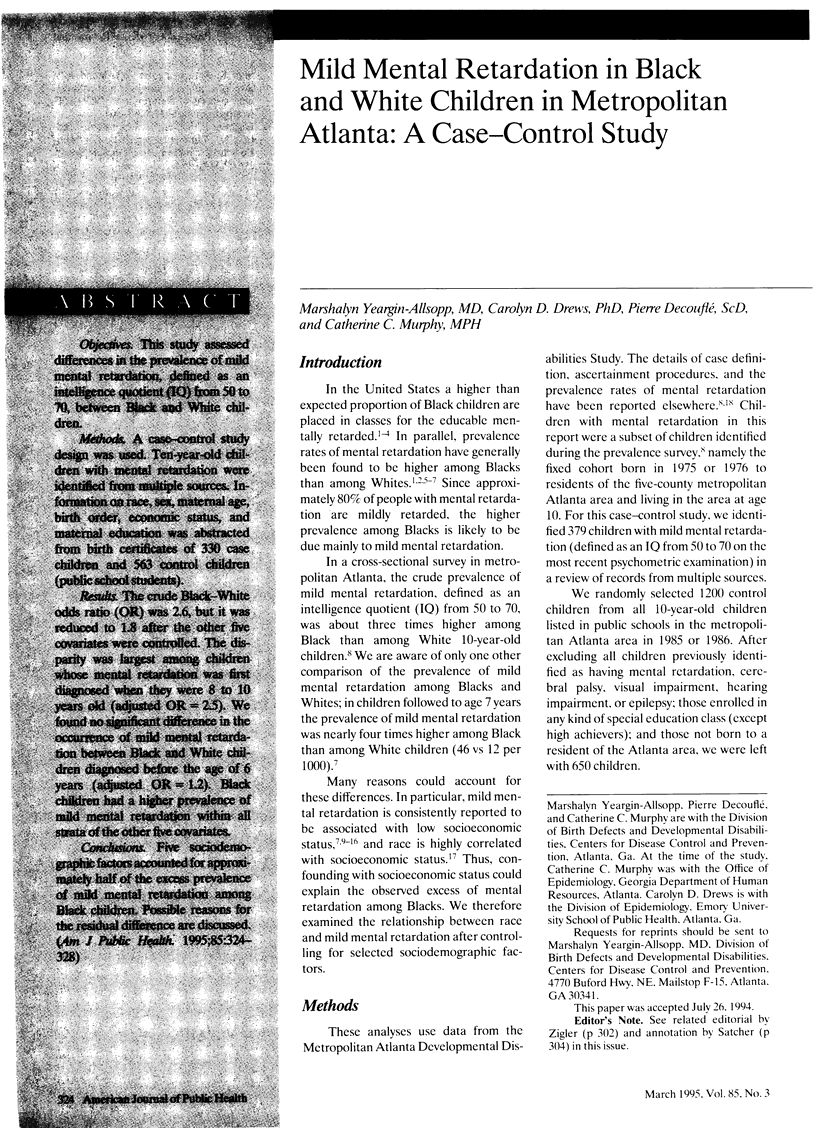
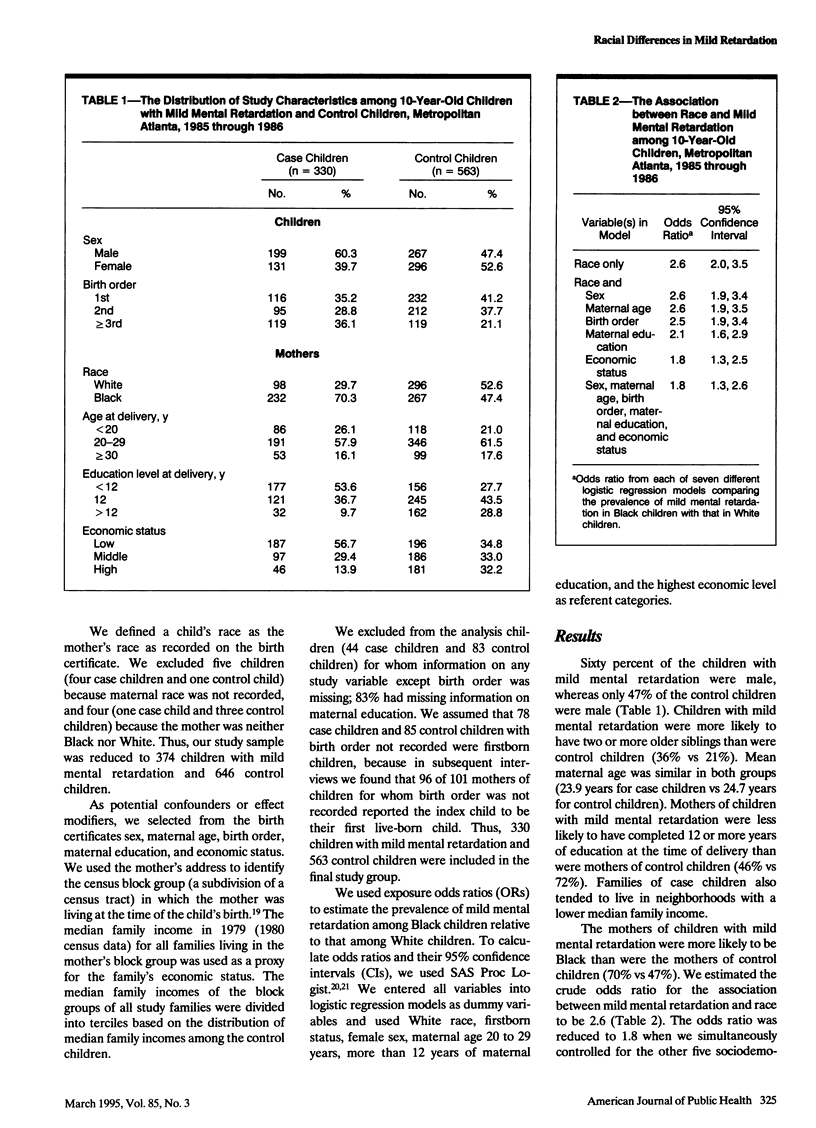
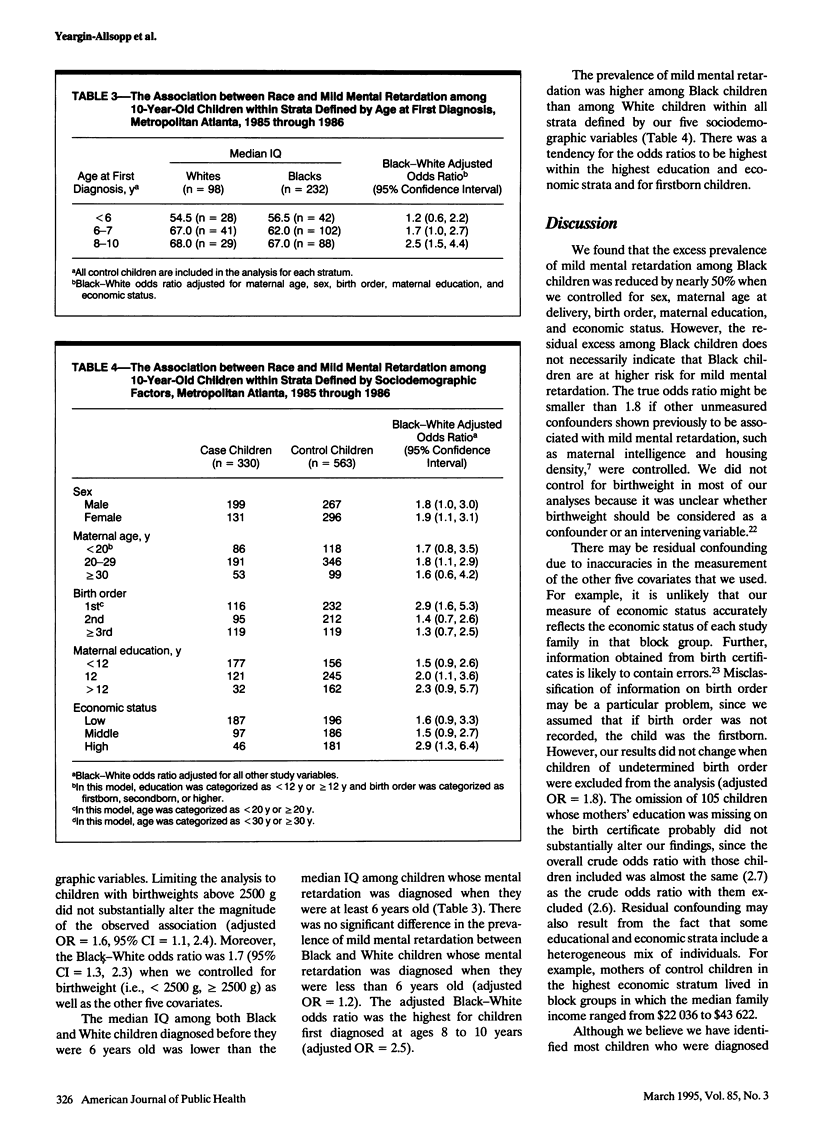
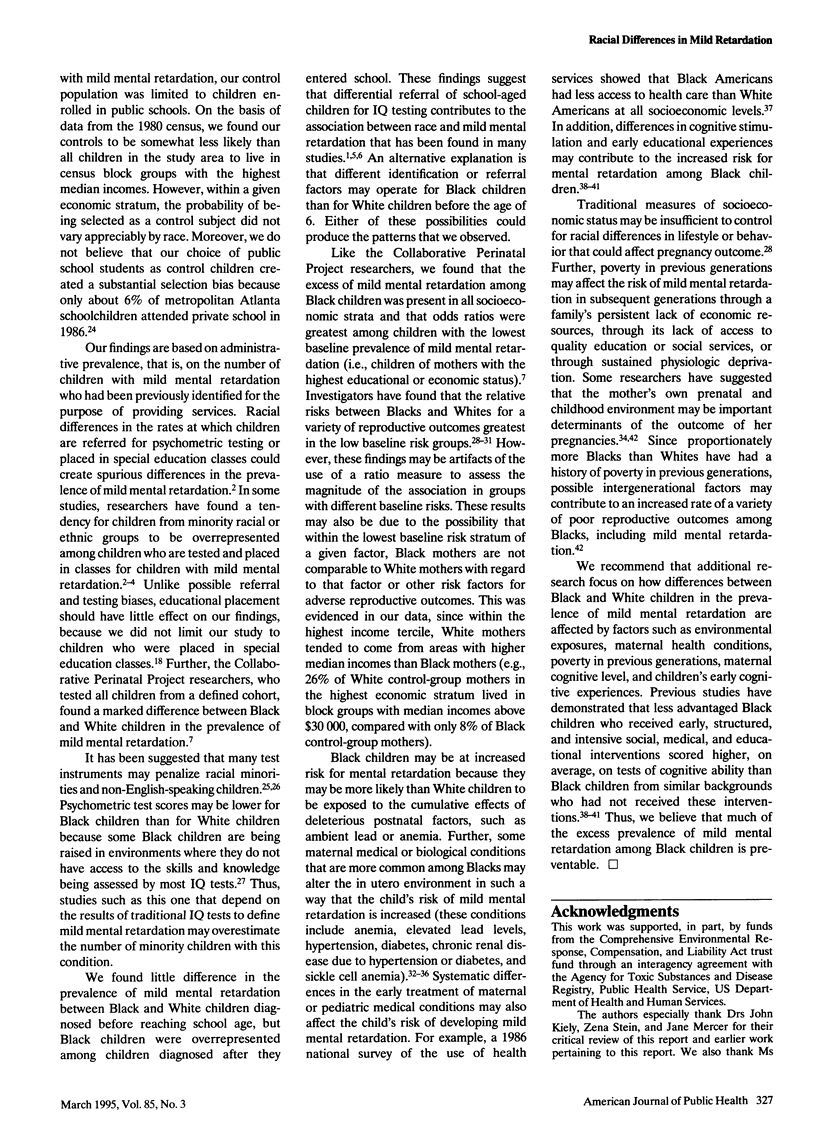
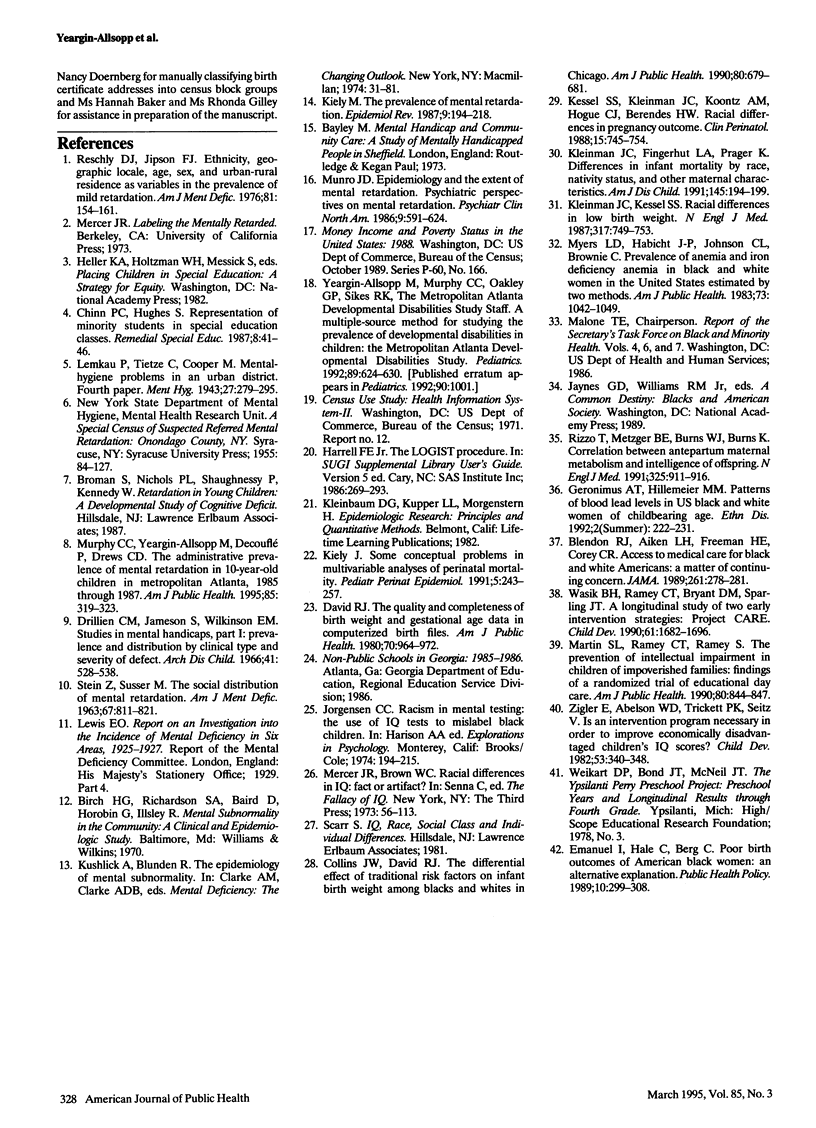
Selected References
These references are in PubMed. This may not be the complete list of references from this article.
- Blendon R. J., Aiken L. H., Freeman H. E., Corey C. R. Access to medical care for black and white Americans. A matter of continuing concern. JAMA. 1989 Jan 13;261(2):278–281. [PubMed] [Google Scholar]
- Collins J. W., Jr, David R. J. The differential effect of traditional risk factors on infant birthweight among blacks and whites in Chicago. Am J Public Health. 1990 Jun;80(6):679–681. doi: 10.2105/ajph.80.6.679. [DOI] [PMC free article] [PubMed] [Google Scholar]
- David R. J. The quality and completeness of birthweight and gestational age data in computerized birth files. Am J Public Health. 1980 Sep;70(9):964–973. doi: 10.2105/ajph.70.9.964. [DOI] [PMC free article] [PubMed] [Google Scholar]
- Drillien C. M., Jameson S., Wilkinson E. M. Studies in mental handicap. I. Prevalence and distribution by clinical type and severity of defect. Arch Dis Child. 1966 Oct;41(219):528–538. doi: 10.1136/adc.41.219.528. [DOI] [PMC free article] [PubMed] [Google Scholar]
- Emanuel I., Hale C. B., Berg C. J. Poor birth outcomes of American black women: an alternative explanation. J Public Health Policy. 1989 Autumn;10(3):299–308. [PubMed] [Google Scholar]
- Geronimus A. T., Hillemeier M. M. Patterns of blood lead levels in US black and white women of childbearing age. Ethn Dis. 1992 Summer;2(3):222–231. [PubMed] [Google Scholar]
- Kessel S. S., Kleinman J. C., Koontz A. M., Hogue C. J., Berendes H. W. Racial differences in pregnancy outcomes. Clin Perinatol. 1988 Dec;15(4):745–754. [PubMed] [Google Scholar]
- Kiely J. L. Some conceptual problems in multivariable analyses of perinatal mortality. Paediatr Perinat Epidemiol. 1991 Jul;5(3):243–257. doi: 10.1111/j.1365-3016.1991.tb00707.x. [DOI] [PubMed] [Google Scholar]
- Kiely M. The prevalence of mental retardation. Epidemiol Rev. 1987;9:194–218. doi: 10.1093/oxfordjournals.epirev.a036302. [DOI] [PubMed] [Google Scholar]
- Kleinman J. C., Fingerhut L. A., Prager K. Differences in infant mortality by race, nativity status, and other maternal characteristics. Am J Dis Child. 1991 Feb;145(2):194–199. doi: 10.1001/archpedi.1991.02160020086023. [DOI] [PubMed] [Google Scholar]
- Kleinman J. C., Kessel S. S. Racial differences in low birth weight. Trends and risk factors. N Engl J Med. 1987 Sep 17;317(12):749–753. doi: 10.1056/NEJM198709173171207. [DOI] [PubMed] [Google Scholar]
- Martin S. L., Ramey C. T., Ramey S. The prevention of intellectual impairment in children of impoverished families: findings of a randomized trial of educational day care. Am J Public Health. 1990 Jul;80(7):844–847. doi: 10.2105/ajph.80.7.844. [DOI] [PMC free article] [PubMed] [Google Scholar]
- Meyers L. D., Habicht J. P., Johnson C. L., Brownie C. Prevalences of anemia and iron deficiency anemia in Black and White women in the United States estimated by two methods. Am J Public Health. 1983 Sep;73(9):1042–1049. doi: 10.2105/ajph.73.9.1042. [DOI] [PMC free article] [PubMed] [Google Scholar]
- Munro J. D. Epidemiology and the extent of mental retardation. Psychiatr Clin North Am. 1986 Dec;9(4):591–624. [PubMed] [Google Scholar]
- Murphy C. C., Yeargin-Allsopp M., Decouflé P., Drews C. D. The administrative prevalence of mental retardation in 10-year-old children in metropolitan Atlanta, 1985 through 1987. Am J Public Health. 1995 Mar;85(3):319–323. doi: 10.2105/ajph.85.3.319. [DOI] [PMC free article] [PubMed] [Google Scholar]
- Reschly D. J., Jipson F. J. Ethnicity, geographic locale, age, sex, and urban-rural residence as variables in the prevalence of mild retardation. Am J Ment Defic. 1976 Sep;81(2):154–161. [PubMed] [Google Scholar]
- Rizzo T., Metzger B. E., Burns W. J., Burns K. Correlations between antepartum maternal metabolism and child intelligence. N Engl J Med. 1991 Sep 26;325(13):911–916. doi: 10.1056/NEJM199109263251303. [DOI] [PubMed] [Google Scholar]
- STEIN Z., SUSSER M. The social distribution of mental retardation. Am J Ment Defic. 1963 May;67:811–821. [PubMed] [Google Scholar]
- Wasik B. H., Ramey C. T., Bryant D. M., Sparling J. J. A longitudinal study of two early intervention strategies: Project CARE. Child Dev. 1990 Dec;61(6):1682–1696. [PubMed] [Google Scholar]
- Yeargin-Allsopp M., Murphy C. C., Oakley G. P., Sikes R. K. A multiple-source method for studying the prevalence of developmental disabilities in children: the Metropolitan Atlanta Developmental Disabilities Study. Pediatrics. 1992 Apr;89(4 Pt 1):624–630. [PubMed] [Google Scholar]
- Zigler E., Abelson W. D., Trickett P. K., Seitz V. Is an intervention program necessary in order to improve economically disadvantaged children's IQ scores? Child Dev. 1982 Apr;53(2):340–348. [PubMed] [Google Scholar]


